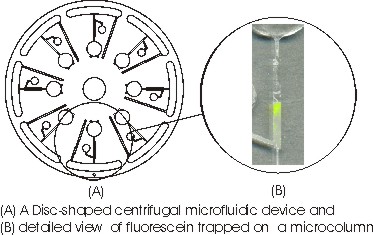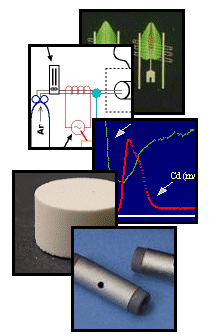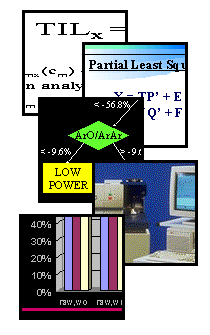Research Interests
Our research has focused in three areas which have proved very synergistic to both our scientific progress and student development: micro instrumentation, spectroscopy and artificial intelligence.
Micro Instrumentation

The primary focus of our work now involves the development of small instruments of the type that are often called micro-Total Analytical Systems (microTAS). The concept is also often called Lab on a Chip or “microfluidics.” Microfluidic systems are of great interest to the analytical community, because they use very small amounts of reagent and sample, micro or even nanoliters. The physical size regime involves channels and other features which are microns rather than millimeters. In this regime, factors like gravity become unimportant, while viscosity and pressure become more important. Since many reactions are diffusion limited, reactions are often done 100 to 1000 times faster since distances are so short. This speed of reaction combined with the use of tiny amounts of liquids makes these exciting devices for exploration. They promise to provide minimal reagent consumption and so, minimal waste and micro costs. Devices can be mass produced, stamped out like computer chips and operated with minimal power. This means that small microTAS systems could be imbedded, perhaps in animals or humans, left at remote sites, or made available to the general public for use by non-chemists. These types of devices offer the potential to revolutionize the application of analytical chemistry.
Our work is primarily focusing on centrifugal microfluidics. Centrifugal systems don’t need separate pumps and offer enormous flexibility with respect to the liquids which can be used. Centrifugal systems can mix, sediment, transfer and do separations, to name only a few of possible operations. Our work concentrates on chemical separations and sample preparation. Projects include:
(1) A magnetically driven sample preparation system to prepare solid samples for analysis on a disk. Samples are expected to range from soils through tissues.
(2) A trapping system for separation and detection of environmentally important species using laser ablation and inductively coupled plasma mass spectrometry.
(3) The conversion of traditional field portable hand done techniques to microTAS centrifugal format using absorption of fluorescence spectrometry.
|
|
Spectroscopy and Environmental Analysis
 |
Our work in this area has been primarily oriented towards elemental analysis. We have developed a wide variety of sample introduction techniques for plasma atomic emission and mass spectrometry (ICP-AES and ICP-MS). These techniques have used electrothermal vaporization, laser ablation, and direct sample insertion techniques as well as flow injection, chromatographic and electrochemical methods. Our sample introduction techniques are generally targeted at environmentally important materials or clinical samples. Recent work has focused on new methods of soil and human hair analysis for toxic metals.
We have also developed microwave based automated digestion methods which reduce operator time and human exposure. In the environmental arena, we have created an adaptive plasma based hazardous waste destruction system, which uses intelligent feedback.
|
Artificial Intelligence
While we are generally interested in the applicability of AI techniques to chemistry, our recent work has focused on the development of autonomous instruments. These are instruments which run totally without human intervention. We are interested in studying both the science, that will provide insight into the what is going right and wrong in an instrument, and the development and testing of algorithms which will approach or perhaps exceed human decision making capability. Recently our work has focused on ICP-AES and ICP-MS, however we hope to develop generally intelligent techniques which will be applicable to many different types of instrumentation including the micro scale instruments mentioned above.
|
 |
|


